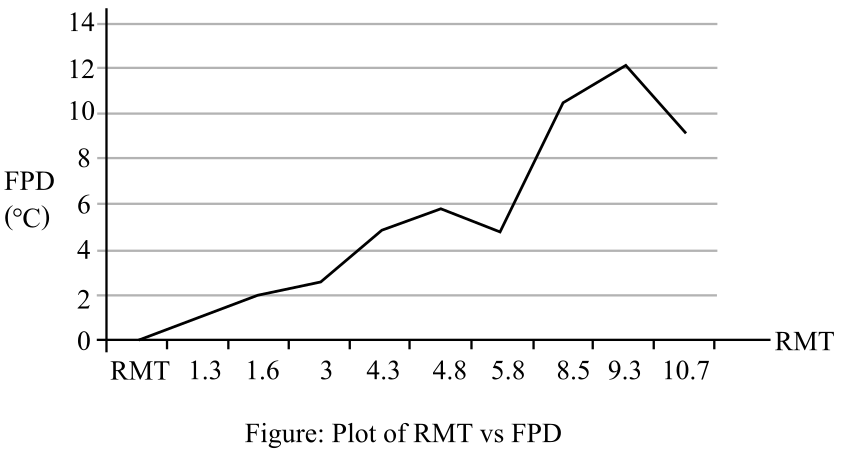
To review:
The relative medullary thickness (RMT) is a good predictor to determine an animal’s ability to produce concentrated urine or not, based on an RMT vs freezing point depression (FPD) plot.
Given:
The RMT and the FPD for different mammals are given in the Table 1:
Table 1: The RMT and FPD of different mammals.
| Animal | RMT | FPD (ᵒC) |
| Beaver | 1.3 | 0.96 |
| Pig | 1.6 | 2 |
| Human | 3 | 2.6 |
| Dog | 4.3 | 4.85 |
| Cat | 4.8 | 5.8 |
| Lab rat | 5.8 | 4.85 |
| Kangaroo rat | 8.5 | 10.4 |
| Jerboa | 9.3 | 12 |
| Sand rat | 10.7 | 9.2 |
Introduction:
RMT refers to the thickness of medulla of the kidney divided by volume (length X width X thickness) of the entire kidney. FPD is a test, which is used to measure the concentration of urine. It is known that fresh water freezes at 0°C, but the addition of solutes lowers this freezing temperature.
Explanation of Solution
The graph plot between RMT and FPD is given in the Figure 1.

Figure 1: Plot of RMT vs FPD.
It can be observed from the graph that as the RMT increases, the FPD also increases. This means that the concentration of the urine increases with an increase in relative length of loops of Henle. The graph follows an almost linearly increasing trend.
A slight deviation from the trend is observed in case of the laboratory rat and the sand rat.
Therefore, it can be concluded that the RMT is a good predictor of the ability of the mammal to produce concentrated urine.
Want to see more full solutions like this?
Chapter 51 Solutions
LIFE:SCIENCE OF BIOL.(LL) >CUSTOM<
- determine if the enzymes responsible for the induction of toleranceto pentobarbitone sodium are also induced by TCPOBOP.arrow_forwardMany types of fishes live in freshwater. Generally, water moves by osmosis from the surrounding fresh water into the fish's body. This observation helps to explain which feature of the excretory systems of freshwater fishes? a. They tend to produce dilute, watery urine. b. They tend to produce concentrated, dark urine. c. They do not produce urine, but instead conserve or re-use nitrogenous wastes. d. They may produce either dilute or concentrated urine, depending on the activity of the fish.arrow_forwardGive the 4 factors affecting the urine volume in physiological system. Explain how each factor affects the volume of urine.arrow_forward
- In IBD1, if 20 mg of a drug is ultimately excreted unchanged into urine, the amount of the drug excreted unchanged into urine after 2 half-lives is _____ mg. Round the answer into the nearest integer.arrow_forwardYou are studying renal function in different species of mammals that are found in very different environments. You look at species from a desert environment and compare them with ones from a tropical environment. The desert species would be expected to havea. shorter loops of Henle than the tropical species.b. longer loops of Henle than the tropical species.c. shorter proximal convoluted tubules than the tropical species.d. longer distal convoluted tubules than the tropical species.arrow_forwardDefine nitrogenous wastes, and list the main types produced in animals.What are some advantages and disadvantages of excreting differenttypes of nitrogenous wastes?arrow_forward
- Given the importance of these ions in numerousaspects of animal biology, is it surprising that there is more than onehormone that regulates Na+ and K+ balance?arrow_forwardCompare and contrast how the kidney can modify filtration rates to produce dilute and concentrated urine Thank you!arrow_forwardAtrial Natriuretic Peptide helps to reduce overall blood pressure in a variety of ways. One way is by increasing Glomerular Filtration Rate. a. Why/how would increasing GFR cause decreased blood pressure? b. To increase GFR, would Atrial Natriuretic Peptide cause constriction or dilation of afferent arterioles at the kidneys? The efferent arterioles?arrow_forward
- Explain the mechanism how furosemide affects kidney tubules. How does this affect K+ balance? How different is the mechanism of thiazide affect urine production? Describe the process of acid-base regulation in human body.arrow_forwardConsidering the distal convoluted tubule of the amphibiannephron, explain how changes in the permeability of the tubulewall to water affect the amount of pure, osmotically free waterexcreted in the urine. Define what is meant by pure, osmoticallyfree water.arrow_forwardGiven: For urea, the rate of excretion equals to the GFR times the urea concentration in plasma. (A) If the urea concentration in plasma is 4.5 mmol/l, what GFR (in l/day) would correspond to an excretion rate of 450 mmol/day. (B) If the urea clearance is 70 ml/min and the GFR is 125 ml/min, what fraction of urea is being reabsorbed. (answer A and B)arrow_forward
 Human Physiology: From Cells to Systems (MindTap ...BiologyISBN:9781285866932Author:Lauralee SherwoodPublisher:Cengage Learning
Human Physiology: From Cells to Systems (MindTap ...BiologyISBN:9781285866932Author:Lauralee SherwoodPublisher:Cengage Learning
